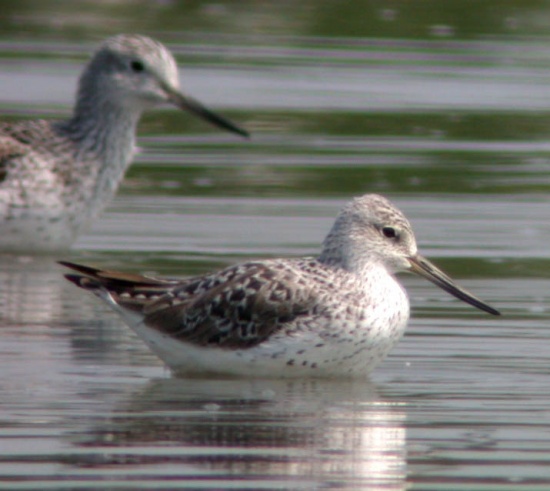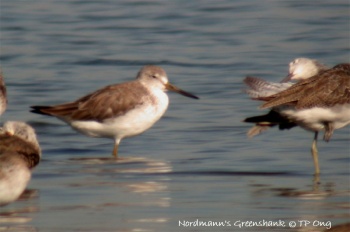m (→External Links: removed BFTV link) |
|||
| (7 intermediate revisions by 3 users not shown) | |||
| Line 1: | Line 1: | ||
| + | [[Image:Nordmann's_Greenshankbp.jpg|thumb|550px|right|Photo by {{user|Bob+Pease|Bob Pease}} <br />Mai Po, [[Hong Kong]], April 2002]] | ||
;[[:Category:Tringa|Tringa]] guttifer | ;[[:Category:Tringa|Tringa]] guttifer | ||
| − | |||
| − | |||
==Identification== | ==Identification== | ||
| − | + | 29–32 cm | |
| − | + | *Bicoloured, slightly upturned, bill | |
| − | + | *Yellow legs | |
| + | *Black upper parts with whitish spots | ||
| + | *Head and neck heavily streaked | ||
| + | *Broad black crescent-shaped spots on lower neck and breast | ||
| + | *Dark [[Topography#Heads|lores]] | ||
| + | *Grey tail<br /> | ||
| + | Juveniles are browner than adults, with a pale brown breast and wing edges. | ||
==Distribution== | ==Distribution== | ||
| − | [[Russia]] | + | [[Image:Nordmanns_Greenshank.jpg|thumb|350px|right|Photo by {{user|tunpin.ong|tunpin.ong}} <br />Big Ash Pond, Kapar Power Station, Selangor, [[Malaysia]], November 2003]] |
| + | Widespread throughout [[Asia]]: found in [[Russia]], [[Siberia]], [[China]], [[India]], Western [[Himalayas]], [[Bangladesh]], [[North Korea|North]] and [[South Korea]], [[Hong Kong]]<br /> | ||
| + | '''Southeast Asia''': [[Indochina]], [[Myanmar]], [[Laos]], [[Vietnam]], [[Cambodia]], [[Thailand]], [[Malaysia]], [[Malay Peninsula]], [[Singapore]], [[Philippines]], [[Indonesia]], [[Greater Sundas]] and [[Sumatra]] | ||
| + | ==Taxonomy== | ||
| + | This is a [[Dictionary_M-O#M|monotypic]] species<sup>[[#References|[1]]]</sup>. | ||
| − | |||
==Habitat== | ==Habitat== | ||
Wet coastal meadows and coastal mudflats, and nests in sparse larch forest. | Wet coastal meadows and coastal mudflats, and nests in sparse larch forest. | ||
==Behaviour== | ==Behaviour== | ||
| − | + | ====Breeding==== | |
| − | + | The four eggs are laid in a twiggy nest placed on thick branches, in thinly wooded swamps. The clutch is incubated by both adults, who then lead the chicks into hiding in coastal meadows. | |
| + | ====Diet==== | ||
Diet includes sticklebacks, terrestrial invertebrates, small crustaceans, molluscs, and worms. | Diet includes sticklebacks, terrestrial invertebrates, small crustaceans, molluscs, and worms. | ||
| + | ==References== | ||
| + | #{{Ref-Clements6thAug13}}#Avibase | ||
| + | #Handbook of the Birds of the World Alive (retrieved May 2014) | ||
| + | #Wikipedia | ||
| + | {{ref}} | ||
| + | ==External Links== | ||
| + | {{GSearch|"Tringa guttifer" {{!}} "Nordmann's Greenshank"}} | ||
| + | {{GS-checked}}1 | ||
| + | <br /> | ||
| + | <br /> | ||
| − | + | [[Category:Birds]] [[Category:Tringa]] | |
| − | |||
| − | |||
| − | |||
| − | |||
| − | [[Category:Birds | ||
Latest revision as of 10:47, 31 May 2023
- Tringa guttifer
Identification
29–32 cm
- Bicoloured, slightly upturned, bill
- Yellow legs
- Black upper parts with whitish spots
- Head and neck heavily streaked
- Broad black crescent-shaped spots on lower neck and breast
- Dark lores
- Grey tail
Juveniles are browner than adults, with a pale brown breast and wing edges.
Distribution
Widespread throughout Asia: found in Russia, Siberia, China, India, Western Himalayas, Bangladesh, North and South Korea, Hong Kong
Southeast Asia: Indochina, Myanmar, Laos, Vietnam, Cambodia, Thailand, Malaysia, Malay Peninsula, Singapore, Philippines, Indonesia, Greater Sundas and Sumatra
Taxonomy
This is a monotypic species[1].
Habitat
Wet coastal meadows and coastal mudflats, and nests in sparse larch forest.
Behaviour
Breeding
The four eggs are laid in a twiggy nest placed on thick branches, in thinly wooded swamps. The clutch is incubated by both adults, who then lead the chicks into hiding in coastal meadows.
Diet
Diet includes sticklebacks, terrestrial invertebrates, small crustaceans, molluscs, and worms.
References
- Clements, J. F., T. S. Schulenberg, M. J. Iliff, B.L. Sullivan, C. L. Wood, and D. Roberson. 2013. The eBird/Clements checklist of birds of the world: Version 6.8., with updates to August 2013. Downloaded from http://www.birds.cornell.edu/clementschecklist/download/
- Avibase
- Handbook of the Birds of the World Alive (retrieved May 2014)
- Wikipedia
Recommended Citation
- BirdForum Opus contributors. (2024) Nordmann's Greenshank. In: BirdForum, the forum for wild birds and birding. Retrieved 10 May 2024 from https://www.birdforum.net/opus/Nordmann%27s_Greenshank
External Links
GSearch checked for 2020 platform.1





